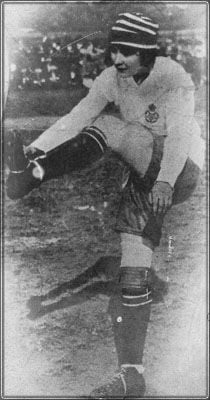Lily Parr, a Pioneering English Footballer, Scores Bronze Monument
Parr rose to fame in the years after WWI, a time when women’s soccer blossomed in the U.K.
/https://tf-cmsv2-smithsonianmag-media.s3.amazonaws.com/filer/73/a5/73a5da2b-8b96-4856-86c9-a9fde3333b65/lilypar.jpg)
During the First World War, when droves of men from the U.K. were sent to the trenches, women became the face of a beloved national pastime: football.
Women’s teams, often attached to the munitions factories where they worked, were known to draw tens of thousands of spectators to matches. One of the most powerful players to emerge during this period was Lily Parr, a 6-foot-tall, chain-smoking left winger who is now being honored with a statue at the National Football Museum in Manchester.
The life-size bronze monument, which will stand outside the museum, is the first statue to represent a woman footballer in the U.K., according to Fiona Tomas of the Telegraph. The artwork was commissioned by the confectionary company Mars, a sponsor of England’s Football Association, and is due to be unveiled in time for the Women’s World Cup, which begins in France in early June.
Hannah Stewart, a Sussex-based sculptor, has been working on the Parr piece for the past six months. “I wanted her to have a look about her that showed she was in control and knows exactly what she is going to do with the ball,” Stewart tells Sarah Page of the West Sussex County Times. “Hopefully each element of the pose contributes to this. Her gaze is fixed and purposeful, while her arms clearly protect her space creating a sense of physical dominance and control.”

Parr was just 14 years old in 1919 when she began playing for Dick, Kerr Ladies, a team largely made up of workers from the railway-turned-munitions factory Dick, Kerr and Co. Founded in 1894, the team was one of the earliest women’s football clubs in the country, and was the first to allow women to wear shorts.
Plenty of other women’s clubs found the opportunity to thrive during and after the wartime years, when men who once made up popular teams went off to the front—many never to return. In the 1920s, according to the BBC, 150 women’s teams were dotted across England.
Dick, Kerr was the best of the bunch, and Parr was its star player. She was a mean left shot and, according to the National Football Museum, scored 43 goals during her first season alone. In 1920, Parr represented England in the first recognized women’s international football game, helping her country beat France 2-0. When Dick, Kerr played against the St. Helen’s Ladies on Boxing Day of 1920, some 53,000 people flocked to Goodison Park stadium in Liverpool to watch the game, with thousands more locked outside.
Just one year later, in spite of the booming popularity of women’s football, the Football Association banned women’s clubs from its grounds, deeming the sport “quite unsuitable for females.” The prohibition remained in place until the late 1960s, but that did not stop Parr from continuing to play; she toured abroad with Dick, Kerr, staying with the team until 1951.
An energetic, somewhat mischievous character, Parr was known to swipe balls from the field and sell them for profit. She also asked for her wages to be supplemented with Woodbine cigarettes.
After her football career came to an end, Parr trained as a nurse and worked in a psychiatric hospital. She was, according to History, also openly gay. Parr died in 1978, at the age of 73. Over the course of her 32 years as a football player, she scored nearly 1,000 goals—a prodigious record that helped her become the first woman inducted into the National Football Museum’s Football Hall of Fame in 2002.
Commenting on the soon-to-be-revealed monument, Marzena Bogdanowicz, head of marketing for women’s football at the Football Association, said that Parr “deserves recognition as a true pioneer of the sport.”
“[I]t’s only fitting that she takes her place alongside other football legends,” Bogdanowicz added, “and becomes the first woman [player] to be celebrated with a statue in her honor.”